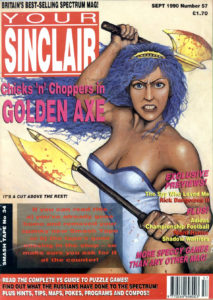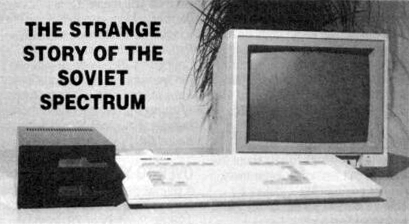Обзор компьютера, который был напечатан в английском журнале «Your Sinclair» №57 (сентябрь 1990г.)

Обложка журнала
HARDWARE
RAGE HARD!
The Hobbit is a Soviet Spectrum clone that does everything Uncle Clive built into the original Speccy, plus a lot of the things he forgot – and it’d only cost you 13 years’ salary to buy one! Join big KEITH POMFRET for…
The other week we had a phone call – there were a couple of Leningrad computer designers in London showing off their brand-new Spectrum-compatible machine, and did we want to see it? Well, of course we blooming well did! Come down to Bath, we said, and let us take it through its paces. The very next day Michail Osetinskij and Dmitri Michailov climbed on the back of Perestroika (well, a British Rail London-to-Bristol loco actually) so we could bring you a report on this powerful new machine.

[THE STRANGE STORY OF THE SOVIET SPECTRUM] Lumme, call this a Spectrum? It’s too sleak and slinky by far!
From Leningrad with love
In the Soviet Union there are no copyright or royalty laws so if you want something you just make or copy it. When Michail and Dmitri needed to produce a computer for the Soviet educational market they chose the Spectrum, but instead of simply cloning it they added a list of features that could show up some western PCs.
Dmitri explained – “In Leningrad, many people get out their soldering irons and make their own computers. It’s the only way. The Spectrum is the most well-documented computer in the Soviet Union, so that is where most people start – there are now at least 20 different Spectrum clones in Leningrad alone, so when we wanted to build an educational computer it was the obvious place to start.”
“A western PC costs 60,000 roubles to buy in the Soviet Union, you see, and even a Spectrum costs 40,000! At 250 roubles a month, that’s just too much.”
As to why the Spectrum is so well-known in the Soviet Union, well, just think of the size of it (especially one of our rubber-keyed chums). What would you want to smuggle through customs – a C64 or something you could hide in the lining of your jacket? (It’s quite obvious really.)
School Prize
Over 15,000 Hobbits have been produced so far and they are used exclusively in schools. The basic machine comes with two 5.25 inch disk drives, networking and more ports than the south coast.
Games players will be chuffed to know that there are three joystick ports on the back. One is Kempston-compatible and the other two are Sinclair. A built-in ROM routine allows the transfer of tape programs to disk, and any TV or standard PC monitor can be plugged straight in. The memory is 64K (though you can switch to 48 mode if you want).
So what’s it like to use?
Well, we powered it up in the YS office to take a look. Right, switch it on and… a-ha! There’s the familiar Spectrum screen… but (of course) it’s in Russian! A single key-press and you can put it back to Uncle Clive’s more familiar English message. In fact, to make it easy for any country to use, the single key-press can take the Hobbit from the Russian Cyrillic script to the Western Roman alphabet or anything else you fancy (once you’ve loaded it in). Another key-press and we could be in Arabic!
The full-sized 74-key keyboard is as comfortable to type on as any conventional PC (and far better than the crappy little things that most Speccies are lumbered with) though the dual Roman/Cyrillic markings on the keys were quite confusing to use. Still, that’s only a problem if you’re a crappy typist like most of us lot – a touch typist wouldn’t look at the keys anyway!
As for what the computer looks like, well, you can see for yourself from the photo. It’s sort of off-white, a bit plasticy and rather basic-looking, but it still manages to look a lot more sophisticated than most Speccies! In fact, it’s all a bit reminiscent of a Lada really – an old (but perfectly good in its time) western design, spiced up and improved a bit in the Soviet Union. Of course, with Ladas they then brought the thing full circle and sold it back to us! Could the same thing happen with the Hobbit? (Read on!)
But how compatible is it with Spectrum programs?
Well, the Hobbit claims full compatibility with all Speccy stuff, legally programmed or otherwise (though of course in the amount of time we had to spend with it we couldn’t really judge how true this is). There’s no real reason to doubt it though – a quick look at the workings inside show that there’s a good deal of Uncle Clive’s original bits and pieces in there!
The Hobbit comes with a built-in diagnostic program monitor and assembler/disassembler that will make life simple for those who like to interfere with their programs. Spectrum Basic is supported (of course) and there’s a Soviet version of CP/M (called Beta) included too, which should open up a whole world of business software to the Hobbit. The educational theme is continued with the inclusion of the graphic and list-processing language, LOGO, and provision for including Pascal, C, and Forth on plug in ROMs.
In Leningrad, where the Hobbit is used in many of the schools, the networking abilities mean that students can do their work and hand it in to the teacher’s ‘master’ Hobbit or PC via the network.
The teacher can also monitor what is going on on any other machine, and in the event of one crashing any other Hobbit on the net can be used to ‘revive it’ and recover files from it. It’s a feature that is especially useful in program development because it allows a teacher to examine the crashed machine to see the state of the various registers.
How about games and magazines though? If the thing’s mainly used in schools, is there any interest in that sort of thing?
The ability to write and develop software is important behind the Iron Curtain. With few western games, peripherals, or magazines getting through, home grown software is valuable currency.
The quality and quantity of computer publications in the USSR is next to zero. Michail said, “The one computer magazine published in the USSR is dry and corporate. We would like a magazine like Your Sinclair that has more life in it.”
But is this all really just of curiosity value, or will we ever see the Hobbit actually sold in this country? Well, maybe. Michail confirmed that though they do actually hope to launch the Hobbit in Europe and the Third World, another important reason for coming to the UK was to visit YS and show us what’s capable behind the (slightly parted) iron curtain! (Sweet of him, eh?)
TECH SPEC
The Hobbit
- Keyboard and processor in a single unit
- Twin 5.25 floppies
- Power supply unit
- Built-in TV/monitor/colour card
Processor
- Z80A running at 3.5MHz
- 64K of addressed memory
- Operating system ROM (16/8/0K RAM used depending on configuration)
- 64K RAM (48, 54, or 64K including 6.5K screen memory)
Interfaces
- System bus (accessible)
- Parallel port (Centronix)
- RS232 serial port
- Three joystick ports (two Sinclair, one Kempston)
Keyboard
- 74 keys including 33 reprogrammable (soft) keys
- Support of Cyrillic/Roman/Arabic alphabet
Disc controller
- All types of SS/DD and DS/DD drives (maximum of four on each machine). Hard disk supported by patching disk-operating system.
Power supply unit
- Independent 5V at 1.5A on 220-240V 50/60 Hz mains power (consumption 7.5 watts)
Video adapter card
- 256×192 pixels
- 24×32 characters in text mode
- 15 colours
- 80 column by 24 lines emulating CP/M supports colour/mono TV
- TTL PC monitor
Peripherals
- Up to four disk drives, including two supplied with each Hobbit
- Cassette recorder
- Printer (serial or parallel)
- Joystick
- Lightpen
- Mouse
Software
- Inbuilt BASIC/LOGO
- Network drivers (100K Baud)
- BETA (CP/M clone)
- Sockets for ROM operating systems (Pascal, Forth, C)
- Fully Spectrum software compatible
FAX BOX
Anyone wanting to contact Intercompex, the company who manufacture the Hobbit, should write to Intercompex, ul. Kalinina 13, 198099 Leningrad, USSR.
